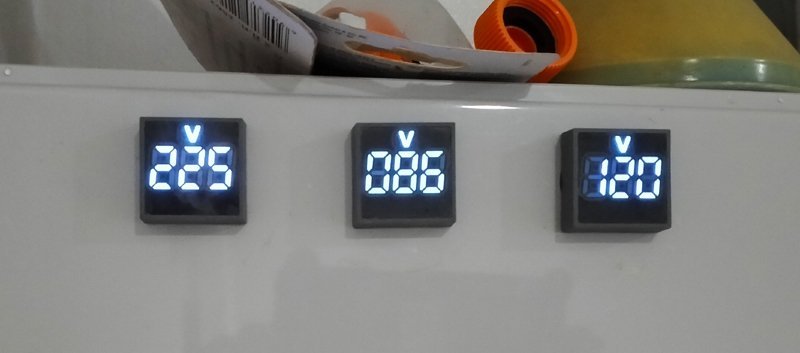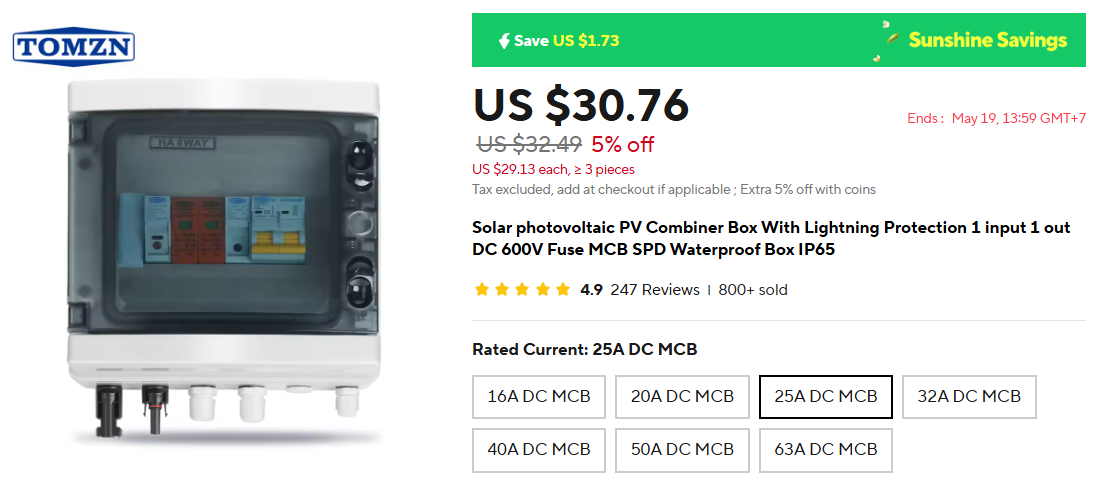
lom
-
Posts
760 -
Joined
-
Last visited
Content Type
Events
Forums
Downloads
Quizzes
Gallery
Blogs
Posts posted by lom
-
-
Btw, the reason for the Neutral getting skewed/offset is that there is no Neutral on the high-voltage side, it is created on the low-voltage side of the transformer and its position as a middle point between phases is dependent on the transformer getting all three phases. With only two high-voltage phases, the Neutral will move its position.
-
 1
1
-
-
21 minutes ago, khunPer said:
To my knowledge neutral is grounded on every second mast. Both remaining phases worked perfect as 220 volt supply.
I don't think it is but if it is it doesn't change anything. The picture does not show "both remaining phases working perfect" it shows one perfect phase and two phases which would have been at 105V each if they were loaded equally by all consumers on the low-voltage line. They are not equally loaded and that will create a skewed Neutral which easily burns equipment for customers. Three single phase protectors like you have does not help against that, you need the type of phase protector/guard that Crossy showed in his post.
-
On 6/29/2025 at 9:03 AM, khunJam said:
Oil provides the best most abundant and reliable energy.
Its main advantage is that it can be easily stored. One of the disadvantages from burning gas and oil in order to produce electricity is that oil and gas prices are globally set and the price Thai consumers pay per KWh is therefore too dependent on that.
-
 1
1
-
-
13 hours ago, khunPer said:
The above is loss of one phase on the high-voltage side and the two remaining phases will only give correct voltage on one low-voltage phase. The neutral from the PEA high to low voltage transformer will become skewed and can cause destroyed consumer electronics. When you have a 3-phase supply you also need a phase guard that disconnects all 3 phases when 1 phase is out.
-
 1
1
-
-
3 hours ago, atpeace said:
I saw one poster stating a 6 year ROI but he just replaced his deep cell batteries he purchased just a few years prior.
I assume you mean deep cycle batteries.
If they are of lead-acid type then they have quite limited lifespan unless you make sure you don't get below 50% depth of discharge so it could have been the reason for replacing them.
If they were old type Li-Ion batteries then it sensible to replace them with LiFePo4 batteries for safety reasons regardless of their condition..
-
 1
1
-
-
3 hours ago, Muhendis said:
I strikes me that there should be an independent frequency source to control national grid frequency nationwide rather than relying on generator frequencies pulling each other into line.
Each generator has to be phase locked to this national frequency.
It was not a grid frequency problem, it was a problem with the frequency of grid reconfiguration. They occurred to fast, were to many to many in a short time period making the grid voltage going quickly up and down (oscillating).
They just had a bad algorithm for the automatic grid reconfiguration.
-
 1
1
-
-
3 hours ago, johng said:
In other words the "green energy" isn't reliable and we should keep
the coal, oil and gas which is. Nuclear as a last resort as it is not very clean or cheap.
I guess you didn't understand this:
On 6/19/2025 at 7:37 AM, Crossy said:"The incident was NOT caused by a lack of system inertia. Rather, it was triggered by a voltage issue and the cascading disconnection of renewable generation plants, as previously indicated. Higher inertia would have only resulted in a slightly slower frequency decline. However, due to the massive generation loss caused by voltage instability, the system would still have been unrecoverable."
-
The Shinawatras seem to have forgotten 2006
-
1 hour ago, Sophon said:
The SPD does have an earthing symbol, to indicate that it has to be connected to earth.
Well then the terminal block has no additional electrical function except that it also grounds the DIN rail.
Without it there would had been a grey stopper block there as there is on the left side.
-
 1
1
-
-
4 hours ago, Sophon said:
What's the purpose of this little earth block in the "combiner" boxes?
The yellow-green colour tells that there should be an earth wire connected.
There is no indication on the surge protector that it has to be earth connected.
-
I'm not a big fan of breakers within a battery case and also not a big fan of small DIN mounted double width DC breakers when it comes to higher current. All my battery packs/stacks use only the external wall mounted bigger MCCB type breakers which have a bigger connection surface and a bigger M6 bolt.
-
 1
1
-
 1
1
-
-
17 minutes ago, Sophon said:
So for my setup, it doesn't really make any difference whether I select "Zero Export To Load" or "Zero Export To CT", other than I don't have to install the CT for the former setting?
Both settings do import from the grid when needed (grid-assist).
Load and Grid are electrically the same but can be divided into two zones with the CT's , before CT and after CT seen from the inverter.
Zero Export to Load doesn't export at all.
Zero Export to CT exports to any device connected between CT and Load terminals (before CT zone) like for instance a high consuming EV charger that you don't want to be connected to the Backup/EPS terminals. The CT will in that case allow export to the before CT zone but will restrict export to the after CT zone.
23 minutes ago, Sophon said:he Deye inverter have some ghost import/export even when set to zero export. I want to avoid this as much as possible.
I have only seen ghost import, no ghost export. Mine is just below 1KW/24h and it disappears when II isolate the system from the grid.
-
10 hours ago, Sophon said:
What happens under "Zero Export To Load" if my house draws more power than is available from PV + batteries?
You get supplemental power from the grid. Same as for "zero export to CT"
-
31 minutes ago, Sophon said:
If the Deye inverter doesn't work without communication established, can I just connect the communication cable between the inverter and the Liyuan battery pack?
Deye uses the Pylon protocol to speak with a master BMS over CAN and the masters uses RS-485/Modbus to speak with the slaves. I'm not sure if you can have one brand of BMS as Master and another brand as slave but if you use all your batteries as slave then Deye can speak with all of them over RS-485/Modbus and you will be able to see each battery's parameters/status in the Deye battery setup.
-
16 hours ago, Sophon said:
I could optimize the production from each string. It would also free up space in my existing CU, as I would no longer need the MCBs to be in there.
Never mix DC and AC in the same CU...
-
16 hours ago, Sophon said:
The incoming supply to the house is buried underground, so connecting the two earths would mean digging up the NYY cable and run a wire between the two earths. Not really something I want to do if I can avoid it.
With regards to the PV panel surge arresters, I was thinking of running each of the three strings through one of these so-called "combiner" boxes:
If I were to do that, what MCB amperage should I go for? My current panels have open circuit amperages of 8.79 to 10.12A, but I would like to have the flexibility to easily connect future panels with different specs (maybe even connect two strings in parallel). Would 25A be a reasonable compromise between safety and flexibility?
When open circuit there will be no current, the current will flow first when the MPPT draws current from the panels.
If you plan for connecting two strings in parallel in the future then use two of the single string boxes above and one 2-to-1 box. The combiner boxes has glass fuses, surge protectors and an MCB for each input string and the combine of two string into one is done on the output of the MCB so you can at any time disable one of the combined strings.
-
1 hour ago, ExpatOilWorker said:
How about a 240 kg 32 kWh battery for 130,000 baht?
Seems to be based on the new MB56 prismatic cell which basically is a double size MB31 and which also has double price, double weight, and double capacity - not much gained at all. Makes it just more difficult to handle, can you imagine bringing one up to your abode at the top of the world? 😆
It is limited to 200A discharge current which is the same as their 314Ah box so take 2 of those instead if you need high current capacity.
-
 1
1
-
-
2 hours ago, Sophon said:
No, definitely an inverter for a 48V battery. The supported battery voltage range is specified as 40-60V.
Well, all the Deye mauals that I have state a 60sqmm cable which also matches what online cable size and current calculators say.
Asking google "What current can a 50sqmm cable handle" gives this AI answer which is correct:
A 50 sqmm cable can handle a current of approximately 209 Amps when installed in air, 177 Amps when installed in a duct, and 217 Amps when installed directly in the ground, according to the Power and Cables website.
-
 1
1
-
-
3 hours ago, Sophon said:
For all other cable connections the size is specifically mentioned as being for copper wires, but for the battery the cable material isn't specified. Maybe it's supposed to be aluminium, but if so it would be nice if they mentioned that.
I think you are looking in a manual for a Deye inverter made for 24V battery.
-
10 hours ago, ExpatOilWorker said:
The 52 symbol is a fuse?
No, it is connection 5 and connection 2 which comes from a switch in the thermostat switching connection 1 (neutral) to either 2 (top element) or 5 (bottom element).
Day Rate - only top element heating
Off-peak - only bottom element heating
-
1 hour ago, hotchilli said:
Not bothered to be honest, Phuket is off my bucket list
Thanks for disclosing that important piece of info, it is essential for us to know to where other posters will and will not be traveling.
-
 1
1
-
 2
2
-
-
26 minutes ago, Muhendis said:
But by any standards that's a lot of power.
Do you think it might might be a world record?
I tell ya, the guy is a living power plant..
-
 1
1
-
-
- Popular Post
17 minutes ago, Muhendis said:Would be good but don't forget that the amount of energy Crossy's potentially harvesting is not constant all day. The power output is quoted as 28.8kWp which only happens when the suns light is perpendicular to the panels. But by any standards that's a lot of power.
I compared his April numbers to mine and I had 1500KWh from solar and 55KWh from PEA. My panels output are half of his ie 14.4KWp and my batteries are fullly charged just after midday. I don't know what to do with the sunshine in the afternoon, guess I have to get an EV soon..😃
-
 1
1
-
 1
1
-
 1
1
-
 1
1
-
29 minutes ago, Crossy said:
So, we have a total of 28.8kWp spread over the three areas.
That a lot of unused energy, imagine if you could use all of that all of the day..
Are you planning to open an EV charging station for the neighborhood? 😉
-
 1
1
-



How much would a solar system cost (ball-park estimate) for a modestly sized home?
in Alternative/Renewable Energy Forum
Posted
Read your meter twice or thrice a day. 8am, 4pm and optionally midnight for week and you will know your energy usage during daytime and nighttime. I don't want to guesstimate what you need since I don't know how power efficient your aircons are, nor do I know how well isolated your house is or which temperature you have set the aircons to.